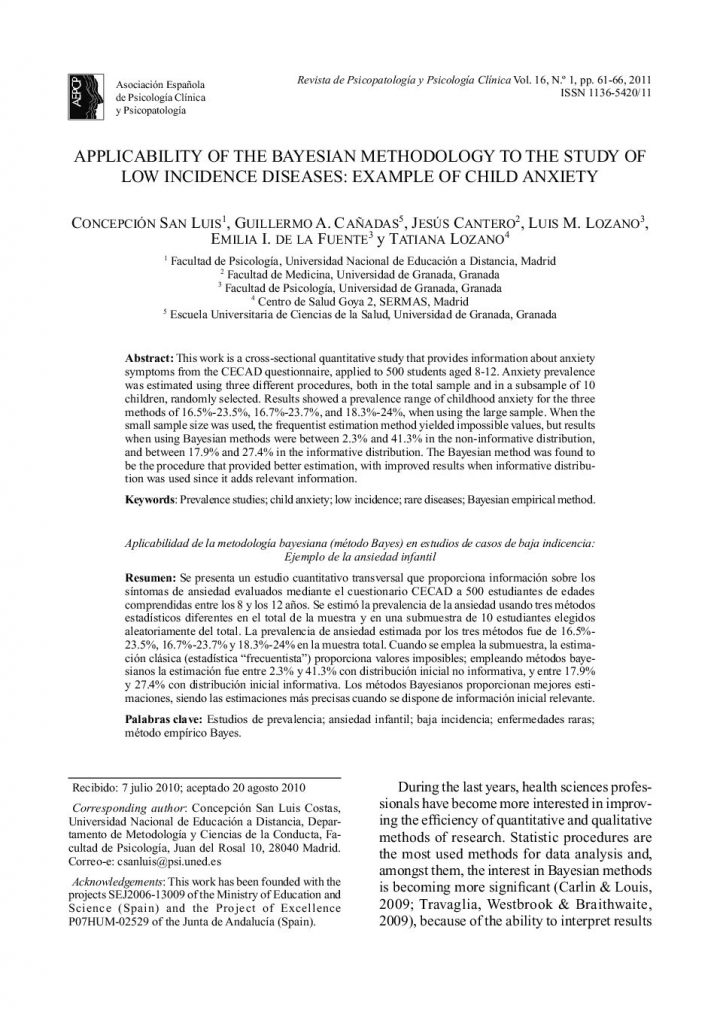Applicability of the Bayesian methodology to the study of low incidence diseases: Example of child anxiety.
Applicability of the Bayesian methodology to the study of low incidence diseases: Example of child anxiety.

- Eficacia de los tratamientos psicológicos basados en mindfulness para los trastornos de ansiedad y depresión: Una revisión sistemática.
- Prevalencia de la sintomatología emocional y comportamental en adolescentes españoles a través del Strengths and Difficulties Questionnaire (SDQ).
- Programa de potenciación de la resiliencia para pacientes con artritis reumatoide.
- Personalidad y síndromes clínicos: Un estudio con el mcmi-iii basado en una muestra española.
- Applicability of the Bayesian methodology to the study of low incidence diseases: Example of child anxiety.
- Trastornos de personalidad en fumadores y personas con dependencia de la cocaína que acuden a tratamiento: Un estudio comparativo.
- de Rivera, J. (2010): Los síndromes de estrés. Madrid: Editorial Síntesis.
- Bell, L. y Rushforth, J. (2010): Superar unaimagen corporal distorsionada: Un programa para personas con trastornos alimentarios. Madrid: Alianza Editorial.
This work is a cross-sectional quantitative study that provides information about anxiety symptoms from the CECAD questionnaire, applied to 500 students aged 8-12. Anxiety prevalence was estimated using three different procedures, both in the total sample and in a subsample of 10 children, randomly selected. Results showed a prevalence range of childhood anxiety for the three methods of 16.5%-23.5%, 16.7%-23.7%, and 18.3%-24%, when using the large sample. When the small sample size was used, the frequentist estimation method yielded impossible values, but results when using Bayesian methods were between 2.3% and 41.3% in the non-informative distribution, and between 17.9% and 27.4% in the informative distribution. The Bayesian method was found to be the procedure that provided better estimation, with improved results when informative distribution was used since it adds relevant information.
Se presenta un estudio cuantitativo transversal que proporciona información sobre los síntomas de ansiedad evaluados mediante el cuestionario CECAD a 500 estudiantes de edades comprendidas entre los 8 y los 12 años. Se estimó la prevalencia de la ansiedad usando tres métodos estadísticos diferentes en el total de la muestra y en una submuestra de 10 estudiantes elegidos aleatoriamente del total. La prevalencia de ansiedad estimada por los tres métodos fue de 16.5%-23.5%, 16.7%-23.7% y 18.3%-24% en la muestra total. Cuando se emplea la submuestra, la estimación clásica (estadística “frecuentista”) proporciona valores imposibles; empleando métodos bayesianos la estimación fue entre 2.3% y 41.3% con distribución inicial no informativa, y entre 17.9% y 27.4% con distribución inicial informativa. Los métodos Bayesianos proporcionan mejores estimaciones, siendo las estimaciones más precisas cuando se dispone de información inicial relevante.



